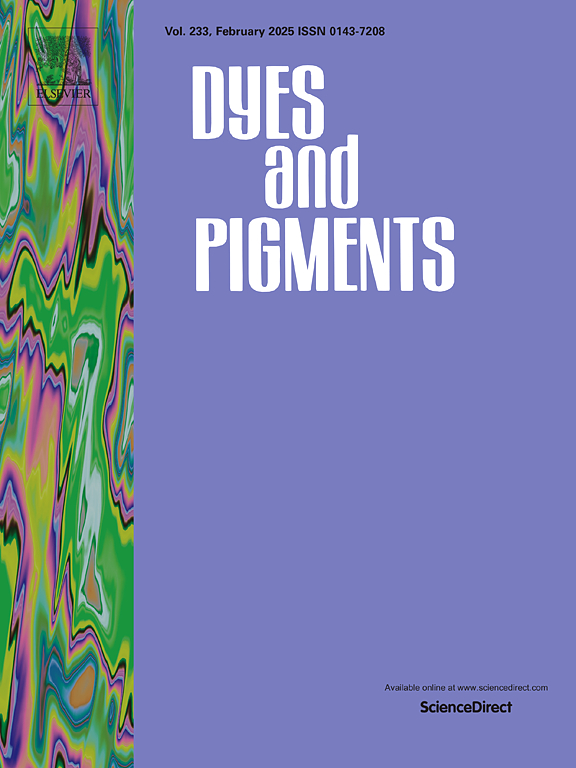Supramolecular Aggregates from core-functionalized 1,8-naphthalimides: insights into self-assembling and sensing ability for drugs in water
IF 4.1
3区 工程技术
Q2 CHEMISTRY, APPLIED
引用次数: 0
Abstract
To monitor emerging pollutants in water, we herein describe three novel core-substituted, self-assembling 1,8-naphthalimide derivatives, applied as fluorescent sensors to detect drugs in water. These fluorophores differ for the substitution on the core and imide positions. We initially studied photophysical properties of the fluorophores by solvent-dependent UV–vis and fluorescence measurements and then investigated their self-assembly, finding that they mostly form J-aggregates in water and water/DMSO solutions, following an isodesmic pathway. We also obtained insights on the thermodynamic parameters of the aggregation process and characterized the aggregate morphology by Scanning Electron Microscopy. Subsequently, we studied how these supramolecular aggregates act as fluorescent sensors to detect in aqueous solutions drugs belonging to different classes, like non-steroidal, anti-inflammatory and antibiotic drugs. To this aim, we conducted fluorescence measurements in the presence of variable drug concentrations. The best-performing system could detect ketoprofen with limit of detection (LOD) and limit of quantification (LOQ) of 2.3 and 6.9 μM, respectively. Finally, we embedded the best-performing fluorophore onto solid supports including filter paper strips or polymer poly(3-hydroxybutirate) films. When these fluorophore-doped solids were soaked in ketoprofen solutions at different concentrations, significant quenching of emission was detected.
核功能化1,8-萘酰亚胺的超分子聚集体:对药物在水中自组装和传感能力的见解
为了监测水中新出现的污染物,我们在此描述了三种新的核取代的自组装1,8-萘酰亚胺衍生物,它们被用作荧光传感器来检测水中的药物。这些荧光团在核心和亚胺位置上的取代不同。我们首先通过溶剂依赖性紫外-可见和荧光测量研究了荧光团的光物理性质,然后研究了它们的自组装,发现它们主要在水和水/DMSO溶液中形成j聚集体,遵循等desdesal途径。我们还获得了聚集过程的热力学参数,并通过扫描电子显微镜表征了聚集的形态。随后,我们研究了这些超分子聚集体如何作为荧光传感器来检测水溶液中属于不同类别的药物,如非甾体类,抗炎类和抗生素类药物。为此,我们在不同的药物浓度下进行了荧光测量。该系统检测酮洛芬的检出限和定量限分别为2.3 μM和6.9 μM。最后,我们将性能最好的荧光团嵌入固体载体上,包括滤纸条或聚合物聚(3-羟基丁酸盐)薄膜。当这些荧光团掺杂的固体在不同浓度的酮洛芬溶液中浸泡时,检测到明显的猝灭发射。
本文章由计算机程序翻译,如有差异,请以英文原文为准。
求助全文
约1分钟内获得全文
求助全文
来源期刊

Dyes and Pigments
工程技术-材料科学:纺织
CiteScore
8.20
自引率
13.30%
发文量
933
审稿时长
33 days
期刊介绍:
Dyes and Pigments covers the scientific and technical aspects of the chemistry and physics of dyes, pigments and their intermediates. Emphasis is placed on the properties of the colouring matters themselves rather than on their applications or the system in which they may be applied.
Thus the journal accepts research and review papers on the synthesis of dyes, pigments and intermediates, their physical or chemical properties, e.g. spectroscopic, surface, solution or solid state characteristics, the physical aspects of their preparation, e.g. precipitation, nucleation and growth, crystal formation, liquid crystalline characteristics, their photochemical, ecological or biological properties and the relationship between colour and chemical constitution. However, papers are considered which deal with the more fundamental aspects of colourant application and of the interactions of colourants with substrates or media.
The journal will interest a wide variety of workers in a range of disciplines whose work involves dyes, pigments and their intermediates, and provides a platform for investigators with common interests but diverse fields of activity such as cosmetics, reprographics, dye and pigment synthesis, medical research, polymers, etc.
 求助内容:
求助内容: 应助结果提醒方式:
应助结果提醒方式:


